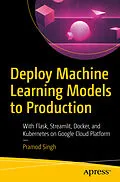Build and deploy machine learning and deep learning models in production with end-to-end examples.
Autorentext
Inhalt
Chapter 1: Configuring Your Deployment Environment
Chapter goal: The chapter showcases what is meant by deployment and what are the challenges associated with it.
&l...
This book begins with a focus on the machine learning model deployment process and its related challenges. Next, it covers the process of building and deploying machine learning models using different web frameworks such as Flask and Streamlit. A chapter on Docker follows and covers how to package and containerize machine learning models. The book also illustrates how to build and train machine learning and deep learning models at scale using Kubernetes.
The book is a good starting point for people who want to move to the next level of machine learning by taking pre-built models and deploying them into production. It also offers guidance to those who want to move beyond Jupyter notebooks to training models at scale on cloud environments. All the code presented in the book is available in the form of Python scripts for you to try the examplesand extend them in interesting ways.
You will:
- Build, train, and deploy machine learning models at scale using Kubernetes
- Containerize any kind of machine learning model and run it on any platform using Docker
- Deploy machine learning and deep learning models using Flask and Streamlit frameworks
Autorentext
Pramod Singh is Manager of Data Science at Bain & Company. Previously, he worked as Sr. Machine Learning Engineer at Walmart Labs and Data Science Manager at Publicis Sapient in India. He has spent over 10 years working in machine learning, deep learning, data engineering, algorithm design, and application development. He has authored three Apress books: Machine Learning with PySpark, Learn PySpark, and Learn TensorFlow 2.0. He is a regular speaker at major conferences such as O'Reilly's Strata Data, GIDS, and other AI conferences. He is an active mentor and faculty in machine learning and AI at various educational institutes. He lives in Bangalore with his wife and four-year-old son. In his spare time, he enjoys playing guitar, coding, reading, and watching football.
Manager of Data Science at Bain & Company. He has over 11 years of experience in the data science field working with multiple product- and service-based organizations. He has been part of numerous ML and AI large-scale projects. He has published three books on large scale data processing and machine learning. He is a regular speaker at major AI conferences.
Inhalt
Chapter 1: Configuring Your Deployment Environment
Chapter goal: This chapter covers the steps right from reading the data, pre-processing, feature engineering, model training and prediction on local as well as on the cloud. This chapter provides the audience with a set of required libraries and code/data download information so that the user can set up their environment appropriately.
Sub -Topics
•Configuring your development environment
•Installing required libraries
•Building Python and TensorFlow based models
Chapter 2: Introduction to Model Deployment and Challenges
No of pages: 20
Sub - Topics
•Understanding model deployment
•Understanding challenges
•Serverless architecture for deployment
Chapter 3: Model Deployment Using Flask
No of pages: 25
Chapter goal: This chapter covers the lightweight web framework Flask for deploying the small and simple machine learning models.
Sub - Topics:
•What is Flask
•Build Python-based model
•Deploy machine learning model using Flask
Chapter 4: Model Containerization Using Docker
No of pages:30
Chapter goal: This chapter is devoted to the understanding of docker platform. It covers all the steps to containerize any model, application using docker.
Sub - Topics:
•Introduction to Docker
•Build a custom Docker image
•Run a machine Learning model using Docker
Chapter 5: Introduction to Kubeflow
No of pages:30
Chapter goal: This chapter serves as an introduction to our core theme of the book: Build and deploy machine learning models using Kubeflow. The chapter begins with covering various components of Kubeflow and offers information on its advantages over other platforms
Sub - Topics:
•Gentle Introduction to Kubernetes
•Introduction to Kubeflow
•Kubeflow components
Chapter 6: Model Deployment Using Kubeflow
No of pages: 35
Chapter goal: This chapter focuses on the industrial implementation of deep learning model in the Google Cloud Platform using Kubeflow. This chapter also demonstrates various techniques like hyperparameter tuning and workflows for training and serving the models for predictions
&l...
Titel
Deploy Machine Learning Models to Production
Untertitel
With Flask, Streamlit, Docker, and Kubernetes on Google Cloud Platform
Autor
EAN
9781484265468
Format
E-Book (pdf)
Hersteller
Genre
Veröffentlichung
14.12.2020
Digitaler Kopierschutz
Wasserzeichen
Dateigrösse
5.3 MB
Anzahl Seiten
150
Unerwartete Verzögerung
Ups, ein Fehler ist aufgetreten. Bitte versuchen Sie es später noch einmal.
